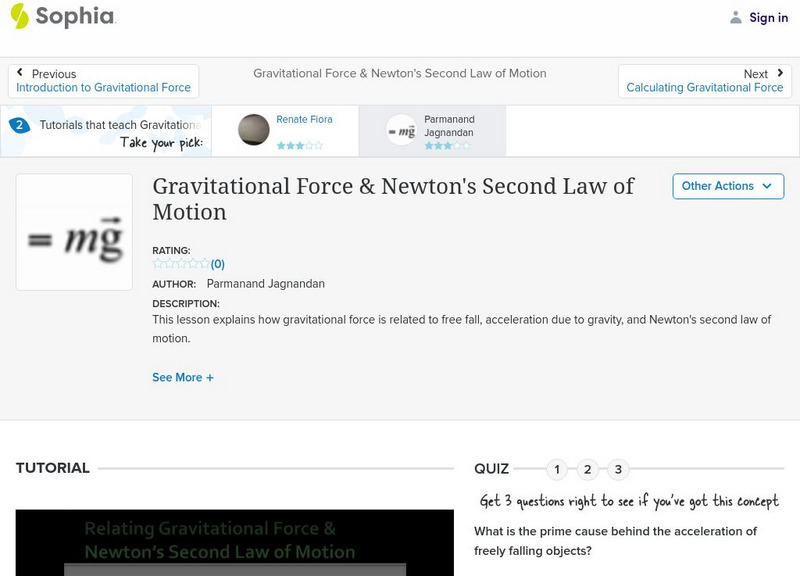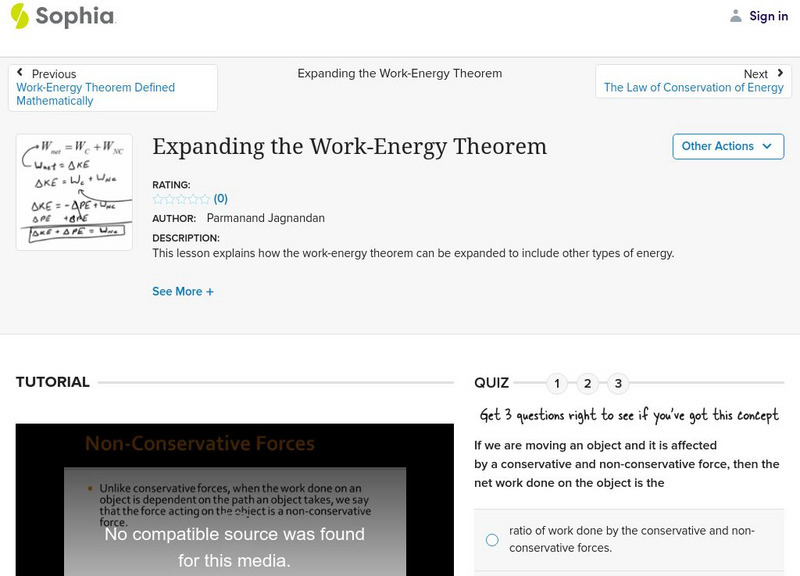Lawrence Berkeley National Laboratory
Berkeley Lab: Four Fundamental Interactions
Discussion of the four fundamental forces of nature: strong interactions, weak interactions, gravity, and electromagnetism.
TeachEngineering
Teach Engineering: Mechanics Mania
Through ten lessons and numerous activities, students explore the natural universal rules engineers and physicists use to understand how things move and stay still. Together, these rules are called "mechanics." The study of mechanics is...
NASA
Nasa: Beginner's Guide to Aerodynamics
This site from NASA uses a colorful graphic to illustrate why objects reach terminal velocity. Provides equation for the terminal velocity of an object. Graphic is accompanied by a simple explanation.
Sophia Learning
Sophia: Gravitational Force & Newton's Second Law of Motion
This lesson explains how gravitational force is related to free fall, acceleration due to gravity, and Newton's second law of motion.
Open Curriculum
Open Curriculum: The Nonmechanical Universe
Students learn about the fields of force and gravity in this illustrated article.
Science Education Resource Center at Carleton College
Serc: Marble Stop
In this two-part lesson, students will discover that no matter what the shape of the track, the marble will rise to the same vertical height. They will begin to understand the concepts of gravity, motion, and force.
Other
Personal: The Laws of Motion
This personal site explains the physics of angular momentum and their application to flight. Part of a much larger site on the procedures, principles, and perceptions of flight.
NASA
Nasa: Kepler's Second Law
This site from NASA states Kepler's second law of planetary motion and depicts its meaning with an informative diagram. Relates the law to conservation of energy principles and discusses the eccentricity of a satellite's (or a planet's)...
BBC
Bbc: Gcse Bitesize: Mass, Weight and Gravitational Field Strength
This lesson focuses on gravitational fields and includes what one is, the formula for gravity force, defining weight, formula for mass, an example of how to calculate gravity force, a practice question, and a link to a test.
Wikimedia
Wikipedia: The Black Hole
This site examines the black hole as an object in astrophysics. Delve into this comprehensive resource that covers this concept from its history, to qualitative physics, the reality of black holes, mathematical physics and more.
Sophia Learning
Sophia: Expanding the Work Energy Theorem
A narrated tutorial which illustrates how the work-energy theorem can be expanded to include other kinds of energy. [10:07]
Other
Center for Education Partnerships: The Marble Roll
In this Science-athon, students try to make their marble roll the farthest across a flat surface, using their knowledge of forces, motion, and energy to guide them through their apparatus design. Teachers must enroll online.
Physics Aviary
Physics Aviary: Practice Problems: Spring Stretch on Other Planet
Students must find the value of the amount of stretch that will occur to a spring on another planet.
Other
National Research Council: Elementary Particle Physics
The Committee on Elementary-Particle Physics, part of the U.S. National Research Council, presents this massive report on particle physics. It's a definitive document. Surprisingly readable, totally detailed. Start with the Table of...
Other
Wikibooks: Physics Study Guide
A handy resource that gives an overview of equations and definitions pertinent to an introductory, college-level physics course, with two of its three sections focusing on motion-related topics and principles.
Science Education Resource Center at Carleton College
Serc: Egg Drop
In this physics lab, learners build a container to safely deliver two eggs from the top of the school. Students calculate average velocity, acceleration, momentum, and the amount of force as it hits the ground. If their egg breaks, they...
Physics Classroom
The Physics Classroom: Satellite Motion
An animation depicting the path of projectiles launched at various launch speeds from the fictional Newton's Mountain. Accompanying text discusses satellite motion and the requirements of orbital motion. Links to further information is...
Woods Hole Oceanographic Institution
Whoi: What Causes Tides?
The Woods Hole Oceanographic Institute provides an in-depth but easy to read article on the role of the moon and the sun in respect to tides.
Physics Classroom
The Physics Classroom: Newton's Laws: Elevator Ride Interactive
Have you ever felt that queasy feeling in a moving elevator? Explore the physics behind the sensations of weightlessness and weightiness. Teacher notes and a downloadable handout are also provided.
PBS
Pbs Learning Media: Newton's Third Law: Action Reaction
An early astronaut's experiences teach students that Newton's third law of motion-for every action, there is an equal and opposite reaction-applies both on Earth and in outer space.
Physics Classroom
The Physics Classroom: Energy Relationships for Satellites
The orbits of satellites are described and an energy analysis is performed. Kinetic, potential and total mechanical energy are explained and applied to the motion of satellites.
Physics Classroom
The Physics Classroom: Kepler's Three Laws
The three laws of planetary motion as described by Kepler are stated and elaborated upon. Useful graphics and an easy-to-understand language are used to explain the nature of planetary motion. Both conceptual and mathematical. Includes a...
Georgia State University
Georgia State University: Hyper Physics: Circular Orbit
The necessity of gravitation to a circular orbit is discussed and equations for the orbital speed are derived from the law of universal gravitation. Binary systems in which two objects orbit about a center of mass are explained and...
Concord Consortium
The Concord Consortium: Molecular Workbench: A Suspended Rope
Adjust the elasticity and mass of a rope suspended between two points to see how it will be affected by gravity.
Other popular searches
- Calculating Force of Gravity
- Force of Gravity Formula
- Force of Gravity Photos
- Force of Gravity Lessons
- Force of Gravity Powerpoint
















